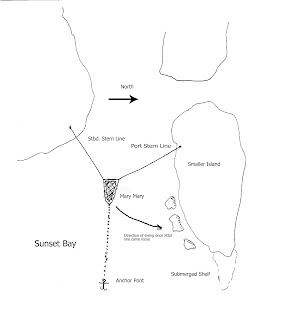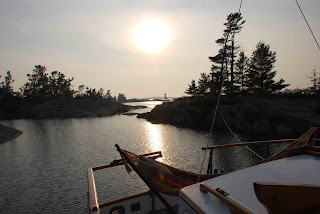What do you do with a drunken
sailor? Wake her up at 6 in the morning and tell her you’ve run aground.
Well, to be sure, we weren’t
drunk. But it had been a frivolous evening and I, for one, didn’t need this
rude an interruption this early in the morning. It was just short of 6 a.m. when I
was awoken by a jolt and a sharp bang. I lay there for a minute wondering
whether this had happened or not or was part of the boisterous dreams I am wont
to have. Another jolt. I leapt from the bed (leapt being an example of
‘literary license’) and went to see what was going on.
The day before we had arrived at
one of our favourite anchorages, Sunset Bay, off of Black Bay, by way of
Georgian Bay and anchored as we had done before, with out bow facing out into
the open bay. We had then sterned into the narrows that occurs between a rocky
outcrop on the large island and the smaller island. Once in position, lines
were spidered out to hold us steady in that place. To do this, we used
climber’s pitons lodged in crevices in the rock and sturdy lines laid to the
stern of the boat. Brooke would run these lines out in Merganser (the trusty
inflatable kayak). There we would ride in relative calm. (See figure 1, below.)
 |
| Fig. 1 |
We knew that next day there would
be high winds, bordering on 30 knots and even higher gusts but we felt secure
there in our little cove. Back to the next morning…
Peering out into the dim daylight
I realized that we had lost our starboard line and had drifted back onto the
aforementioned smaller island. There the port-side hull was banging up against
the protruding rocks.
“We’re on the rocks!” I shouted
down below through the cabin door. Brooke was up in a flash (more literary
license) and joined me on deck to assess the situation. Fortunately, there
wasn’t a lot of push to the starboard side as we were still in the lee of the greater
land mass and the waves were nothing to speak of as they rounded the point. It
seemed that we would be able to pull her off by using the anchor rode (3/4” nylon rope at the time with 55’ in the water) against the
anchor. I went forward and started to pull us forward, hand over hand. The boat
responded and a few seconds later we were off the rocks and floating out in the
bay, anchored at the bow and still tied off at the port stern to the small
island.
Brooke looked down into the
engine room to check for damage to the hull and possible leakage. There was nothing
to be seen there. That was a relief. Now we had to decide what to do as the
wind was beginning to pick up even now.
My first notion was to return the
boat to its previous position and re-tie. Brooke agreed. It was then that I
made my first mistake. I reasoned that if I used the port tie as a sort of
spring line, I might be able to bring the stern back to its original position
without the need for Brooke to get back into the kayak and remove the island
tie. With the engines running, Brooke manned the anchor rode to let it out at
we retreated back to the cove. At one point when the boat was reversed, the
boatswain had drawn the rode all the way back to the stern, not wanting to let
go control of the anchor line, but needing to draw in the stern line. I set the wheel to put us sharply to
starboard, but unfortunately, the stern line got caught under the swim
platform, sagged and fouled onto the port propeller shaft. Adding to this, the
kayak painter, which was secured to a stanchion at the rear became caught in
the now fouling line and together they twisted together to form one large,
knotted ball of rope, pushed up tight against the swim platform and the port
propeller now firmly fouled. This posed two problems; the port engine was no
longer available to me and, more importantly, we were now starting to drift
onto the rocks that formed an underwater shelf running off the near end of the
island.
“We have to cut the rope,” Brooke
called out, so I ran to the galley to fetch a knife. Seizing a large, serrated
carving knife from the kitchen drawer, I ran out onto the deck and cut through
the rope to the island. Thankfully, it parted quickly and we were able to pull
the boat further off.
Shivering in the cold morning
air, we stood together and caught our breath as we peered over the side. Since
the imminent danger of the rocks was over for the time being, the reality sank
in that I would now have to go over the side, down into the still chilly waters
to cut the rope free from the prop.
A couple of years earlier, on
Rice lake, we had had a badly fouled prop and it had taken ages to get it off.
It’s exhausting work. You have to don a swim mask and, holding onto your knife,
use your free hand to get down under the water beneath the hull and find a
place to grab onto while you hack away at the rope until it comes free. This,
of course, can only be done for a few seconds at a time as your breath runs
out, exacerbated by the exertion of doing the cutting. In that case, it had
taken an hour of constantly catching my breath and re-submerging to continue
the work. I remember we tried to fashion a breathing tube out of a piece of
garden hose. This, in case you’ve never tried it, doesn’t work as the pressure
is too great for your lungs to overcome underwater. Thought I was gonna die,
that time. So now, faced with the potential prospect of an even greater fouling
in even colder water, I was, to say the least, daunted.
But it had to be done so over the
side I went to begin the hacking. I was pleased to see, upon my first dive,
that the fouling wasn’t nearly as bad as that previous time. I hyper-ventilated
a little to give myself more oxygen and dove under. I grabbed onto the
propeller blade and began to saw at the rope with the big carving knife. The
first strands gave way. Soon, I realized that Brooke was in the water too,
wearing another mask and one swim fin. (She could only wear the one because of
her badly sprained ankle mentioned in the previous blog.) After I made another
couple of dives, Brooke said she thought she could get the rest and, diving
down, pulled on the sawed and knotted remains until they came away. We were
free.
Now came the chore of
re-positioning the boat to meet the high winds that we were expecting from the
SE. We decided to find another anchor location further into the bay. We motored
in a bit and set the anchor, this time with a heavy chain rode, and I held the
boat in position as Brooke, fighting the already mounting winds, kayaked
ashore, attached a rope to a wedge piton punched into a crack in the rocks and
fed the bitter end back to the boat where she secured it to a cleat. We now had
the anchor out and the boat tied to shore. She then ran another line out and we were
in the clear for the time being. Back on board, Brooke made us French toast
which was as welcome as anything you can imagine, food-wise.
 |
| Sunset Bay in calmer times |
Later we took another swim to
assess the damage done to the hull by the rocks the night before. We were
relieved that it only amounted to some minor chipping of the gel-coat and paint
scrapes.
Then the wind came.
Unfortunately for us, the wind
had now shifted to the SW as it began to build, which meant that it would be
hitting us directly on the beam (sideways). It didn’t take long before it had
reached most of its momentum. It had been forecast as 30 knots with gusts up to
56 knots. In case you’re not familiar with the scale of things, a 30 knot wind is
gale force. We watched the lines to shore strain with the force of the sideways
push on the boat. I began to wonder if this wasn’t actually a squall that was
hitting us. There had been an earlier ‘squall warning’ for Georgian Bay on
Environment Canadas site. (Squall - a sudden violent gust of wind or a
localized storm.)
 |
| The Beaufort Scale of wind strengths |
We went inside to escape the
brutal wind and every now and then I would venture out to have a look at how
the lines were behaving. I was just about to come in from one of these
inspections when the piton-mounted line came flying out of its crevice. We were
now being held to the land by only the thinner of the two lines which was
stretched as taut as a bow string. If it snapped, the boat would be driven
around quickly in the direction of the prevailing wind and we would face the
chance of the anchor pulling free or of finding ourselves helplessly pinned
against rocks protruding further up the bay. Not to mention the danger of
having that line burst, whip-like, while one of us was close by on deck and
taking it in the face.
Brave Brooke jumped into the kayak
and, with amazon-like ferocity, paddled in to secure the wayward line. She did
so and then we even took another line ashore for additional security. Once all
those were in place, I walked around to the bow. I was doubly glad now that we’d
had the good sense to deploy our heavy chain rode with as much scope played out
as we could under the circumstance. But as I stood there, with some difficulty
against the blistering wind, I could only stare down at the waves crashing
around the rode and pray that the anchor held. If it didn’t, now that we were
tied up three ways on the shore, the boat would pivot around those lines and we’d
end up hard against the rocky shore parallel with the land mass.
Bed time.
Inside the boat, the wind could
be heard howling through the mast lines (as Brooke said, “spoiled devil-child
phantoms in tantrum”) and smattering against the windows. We could only sit
there and hope for the best. The anchor chain, straining against its runner
creaked and groaned through the hull. The wind was relentless, gusting from
time to time to its full 55 knot force.
Once in bed, I fought the urge to
throw up and, in fitful bursts, ‘slept’ until the morning which came eventually
along with diminishing 20 knot winds.
20 knots! Luxury!
 |
| Another view of our cove with the port-side stern line attached |
No comments:
Post a Comment
Thanks for getting in touch. Unless you want to remain anonymous, you need to include your name in your comment so we know who it is from. Up to you!